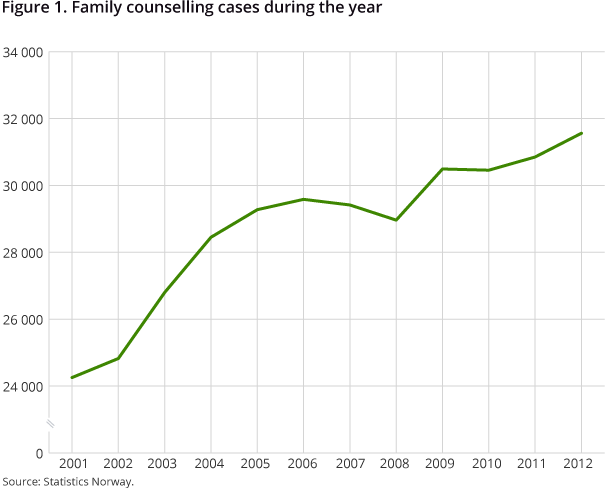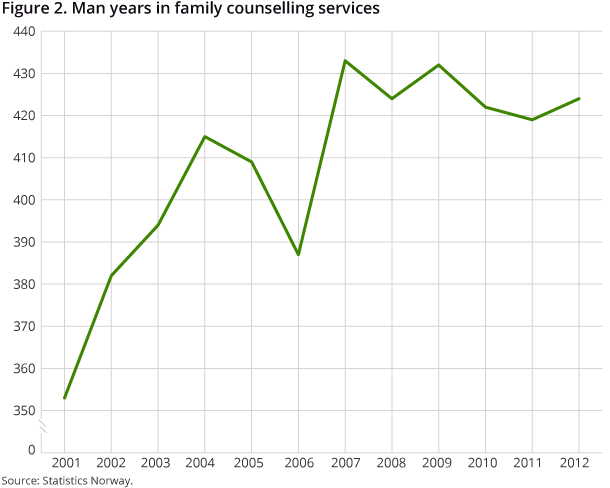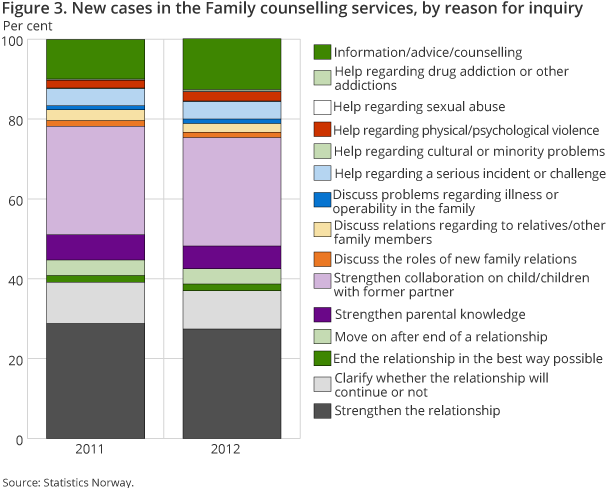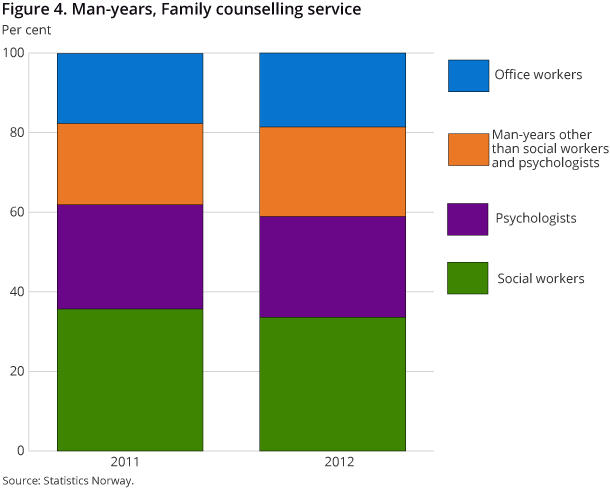Content
Published:
This is an archived release.
More unmarried and divorcees in family counselling
The family counselling offices dealt with 31 600 cases in 2012; an increase of 2 per cent from the year before. More of those who made contact were unmarried or divorced, and fewer made contact with a view to strengthening their relationship. More wanted to strengthen the collaboration on children with a former partner.
| 2012 | |
|---|---|
| Both sexes | 31 560 |
| Males | 10 328 |
| Females | 21 232 |
| Region | |
| Region East | 12 073 |
| Region South | 6 173 |
| Region West | 5 263 |
| Region Middle | 4 166 |
| Region North | 3 885 |
| Average waiting time per case | 29 |
| Average duration per case | 140 |




In Region South, Region East, Region Middle and Region North there was an increase in the number of cases. In Region Vest there was a decrease of nearly 200 cases. Region North has most cases in relation to number of inhabitants, i.e. 8.2 per 1 000 inhabitants. As in previous years, Region West has the lowest number of family counselling cases; 5.0 per 1 000 inhabitants.
More made contact for information and advice, less for strengthening of the relationship
In 2012, there were roughly 24 900 new cases. In 27 per cent of these cases, the primary client reported that strengthening the relationship was the main reason for the enquiry; a reduction of 2 percentage points from the year before, which is the largest percentage decrease for type of enquiry. About 27 per cent of the clients contacted a family counselling office to get help to strengthen the collaboration on a child/children with a former partner, the same level as the previous year. Thirteen per cent of the enquiries were to obtain information, advice and counselling; an increase from 10 per cent from the previous year. This was the largest percentage increase from the year before. Ten per cent needed help to clarify whether the relationship should continue or not. Strengthening parental knowledge was the main reason for enquiry for 6 per cent, and for 4 per cent of the clients the primary reason was to move on after the end of a relationship. Help regarding a serious incident or challenge was the primary reason for 4 per cent of the clients. These shares are similar to the year before. Two per cent of the enquiries related to clarifying the relationship to the rest of the family; a reduction from 3 per cent the year before. Similar proportions related to help because of physical and/or psychological violence, and help to end the relationship in the best way possible; the same level as the year before (see figure 3).
Most people who contacted a family counselling office; 68 per cent, did so because of a recurring problem in the relationship with the spouse, children, parents or other relatives. The corresponding proportion was 67 per cent the year before. Twenty per cent of the enquiries involved an acute crisis; a decrease of 2 percentage points from the year before. Twelve per cent of the new cases dealt with preventing a problem, which is an increase of one percentage point from the previous year.
More unmarried and divorcees, less couple counselling
In 2012, 67 per cent of those who made contact with family counselling offices were women, and 33 per cent were men. Forty-three per cent were aged 35-44, 26 per cent were 25-34 years and 24 per cent were over 45 years. The proportion of clients under the age of 25 was 7 per cent in 2012. Thus, the gender and age distribution of clients of the family counselling services are similar to the previous year.
Among the 31 600 people who contacted the family welfare in 2012, the proportion who were unmarried was highest (45 per cent), which represents an increase in the proportion of 2 percentage points from the previous year. There was also a decrease of 1 percentage point for married and registered partners, accounting for 36 per cent of those who made contact. For those who were legally separated, the share remained stable at 7 per cent. With regard to the proportion of divorced clients, there was an increase of 1 percentage point. Divorced clients amounted to 12 per cent of those who contacted the family counselling services in 2012.
Forty-three per cent of the 97 500 sessions in 2012 included a partner. Former partners took part in 14 per cent of the sessions, and children under 18 years of age took part in 5 per cent. The average number of sessions per family counselling case during the year was 3.
The average waiting time per case was 29 days in 2012; the same level as the year before. The average treatment time after the first session was 140 days for the cases that were closed in 2012, compared with 136 days the previous year.
The total number of sessions during the year increased, however, by 2 per cent from the previous year.
In other words, we can say that there were more cases in 2012 than the year before and more sessions were spent on the clients. The waiting time was the same, but processing time in days increased.
Man-years
In 2012, the number of man-years in the family counselling service was 424; an increase of 5 man-years from 2011. For professions other than social workers and psychologists, and for office workers, there was an increase in man-years. For social workers and psychologists there was a reduction in man-years. With regard to the number of man-years per 10 000 inhabitants, there has been almost no change from 2011.
The family counselling offices also provide information, courses and guidance, and the total number of man-hours spent on outreach activities was about 21 300 in 2012; a decrease of 2 per cent from 2011.
The national child welfare and family counselling service spent almost NOK 345 million on family counselling in 2012; an increase of 5 per cent from the previous year.
Merging of Family counselling offices in 2012Open and readClose
- Family counselling office in Stavanger and Family counselling office in Egersund merged into Family counselling in Sør-Rogaland.
- Family counselling office in Førde and Family counselling office in Sogndal merged into Family counselling in Sunnfjord and Sogn.
Contact
-
Vibeke Sky
E-mail: vibeke.sky@ssb.no
tel.: (+47) 40 90 24 05
-
Unni Beate Grebstad
E-mail: unni.grebstad@ssb.no
tel.: (+47) 94 50 68 66
